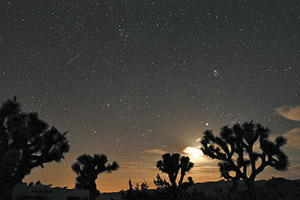
Want to see with your own two eyes the spilled “milk” in the Milky Way and dozens of shooting stars streaking across the night sky?
Just haul yourself down to Mitzpe Ramon, a small town in the middle of Israel’s Negev Desert, this week, and roll your sleeping bag out for what the late TV personality Ed Sullivan used to call “a really big show.”
There, you will find amateur astronomer Ira Machefsky holding forth on the miracle you see before you, explaining why the second week of August is the time to see the year’s best display of shooting stars (well, they’re actually meteors, but more on that later)—as many as 60 per hour.
Peaking late Aug. 12 and early Aug. 13, the Earth’s orbit around the sun plows us smack dab into the path of an old comet, releasing loads of debris. This debris plummets to Earth, passing through the atmosphere and burning up in the sky, which is what we experience as shooting stars.
Indeed, thanks to the sheer volume of the debris, the annual Perseids meteor shower (thought to originate in the constellation Perseus) can be seen by the naked eye pretty much anywhere in the world (especially in the northern hemisphere) from Aug. 11-16, says Machefsky, with the rate soaring from a typical one-two an hour to the aforementioned 60.
So what’s so special about the Negev?
“You have to be able to see the sky, and in our modern day, that’s no easy thing,” says Machefsky, a retired hi-tech professional who made aliyah from New Jersey in 2009. Light pollution is a problem in the entire civilized world, he adds.
“These days, all of Israel from Be’er Sheva north is aglow; it’s encroaching all the time. But here in the middle of the Negev where the sky is open horizon to horizon, you can actually see what city people never can,” Machefsky says.
Dr. Yigal Patel, an astronomer who teaches at Bar-Ilan University near Tel Aviv, says the view also tends to be more dramatic in the desert air. This year, he points out, there is a special bonus.
“It’s a new moon next week, so we won’t have that glare,” says Patel.
But for Israelis looking for company—and lots of it—to count shooting stars with, some 10,000 star-gazers were expected to show up at the Mitzpe Ramon soccer stadium for a Perseids meteor show the night of Aug. 11. On that night, the crowd in the bleachers will cheer not for how many goals their team scores, but for how many meteors shoot by. The town switches off its streetlights, and many homeowners do the same for their own lights. In fact, even some military buildings cooperate, all in an effort to maximize the darkness and thereby the effect of the meteor show.
“It’s terrific because the town goes dark that night and the closest mall—malls are notorious light polluters—is in Be’er Sheva 90 kilometers (56 miles) away,” says Machefsky.
Renee Hirsch of Jerusalem is planning to head back down to Mitzpe Ramon for her second viewing of the Perseids, having stretched out her sleeping bag in the crater alongside dozens of other members of the Mosaic hiking group two years ago.
“The darkness was so complete and peaceful,” she says. “And then you have the excitement of ‘There goes one! And there goes another!’ It’s the amazement of catching it and then catching it again.”
Yet, despite the big build-up, there’s no predicting exactly how this year’s Perseids is going to go.
“Of course, all the conditions can be in place, but you can’t predict the way it’s going to play out this year,” Machefsky says. “You can make all the forecasts you want, but you can never tell what Mother Nature has in store.”
By Deborah Fineblum Schabb/JNS.org









